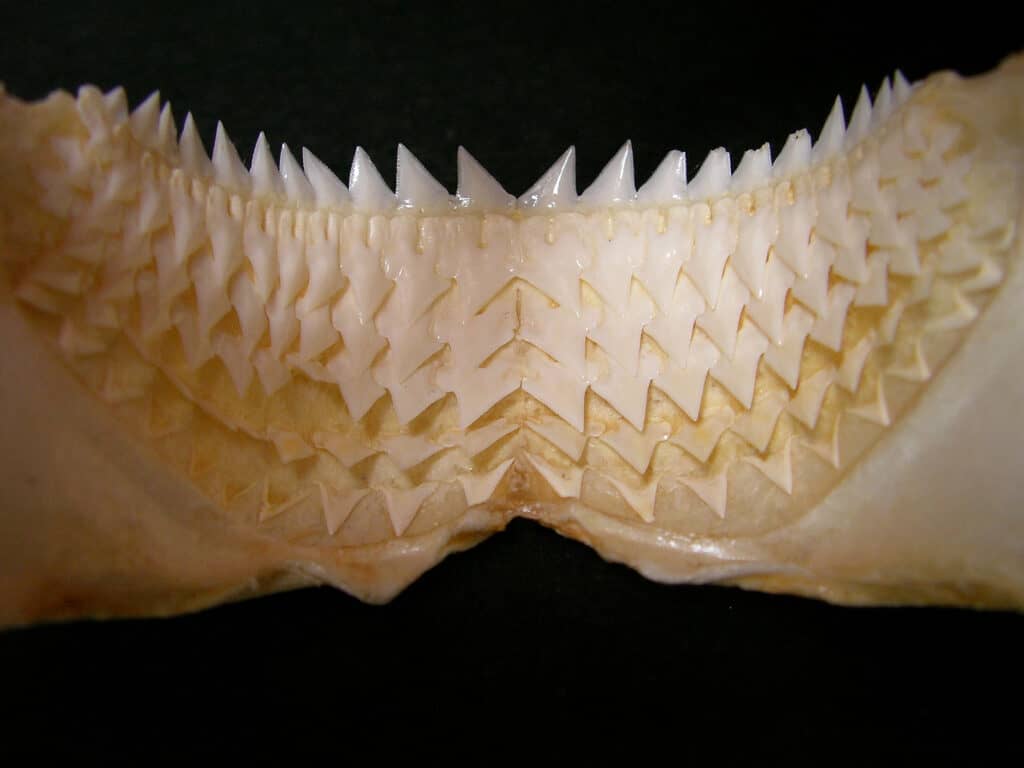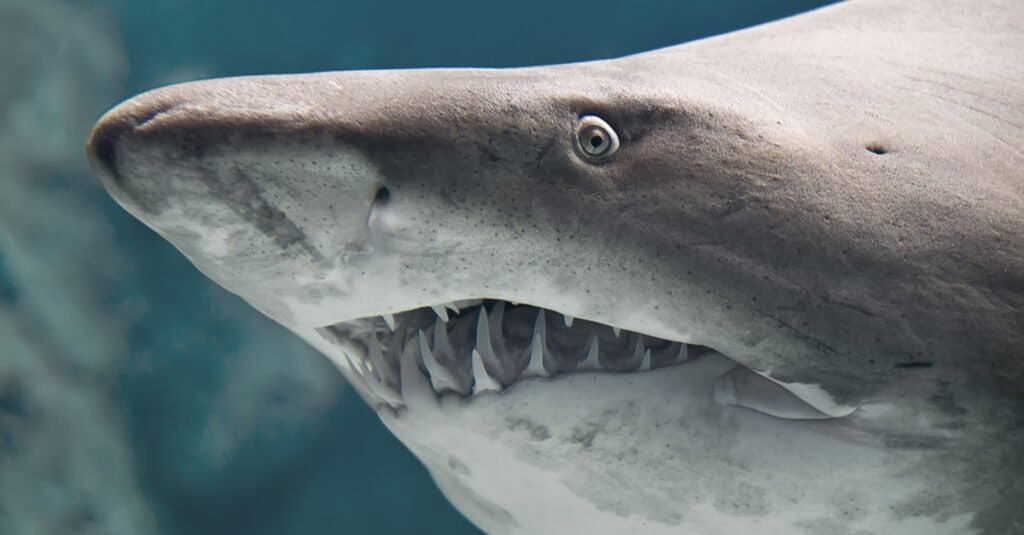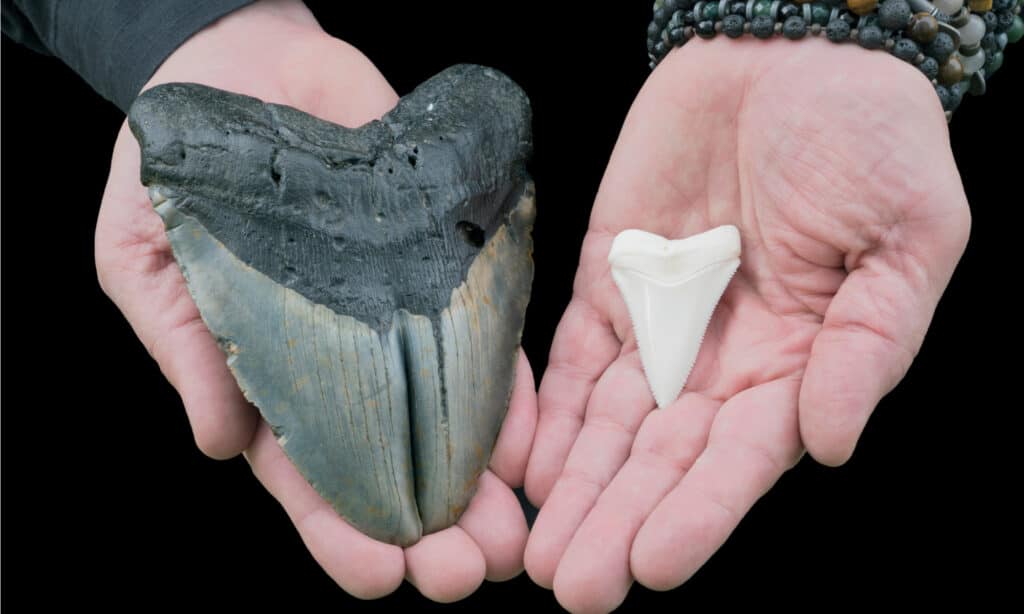Sharks are perhaps some of the most notorious animals in the world and have a reputation for being blood-thirsty killers, owing in part to films such as Jaws. They are incredibly powerful animals and have some of the strongest bite forces around. However, to go with this raw power they also have incredibly sharp and terrifying teeth. There are four different types of shark and they all have different features. So, let’s take a look at them and discover what is so unique about them.
How Many Teeth Do Sharks Have?

Shark teeth are arranged in several rows, allowing a new tooth to move forward every time one is lost.
©Alessandro De Maddalena/Shutterstock.com
Before we talk about the types of teeth that sharks have, it’s important to understand how shark teeth are arranged in the mouth and how many they have. Unlike most animals, sharks do not have an upper jaw which is fixed to their skull. Instead, they are able to detach their jaw when they are attacking their prey as their jaw sits below their skull. This is the reason that sharks have such a powerful bite as they are able to open their mouth wide and bring their upper jaw down with immense force. However, to go with their raw power, sharks also have the unique ability to replace their teeth throughout their lifetime.
Depending on the species, sharks typically have between 50 and 300 teeth in their mouth at once. However, these aren’t arranged in just one row, as you might expect. Instead, they actually have up to several rows of teeth. Most sharks have an average of fifteen rows, although some can have up to fifty rows!
Although shark teeth are made from very tough dentin, they don’t actually have roots to hold them in place. This means that they fall out very easily, especially when sharks are chomping down on large prey every day. Many sharks can lose several teeth every week, although this does depend on what they are eating. Incredibly, when one tooth drops out the new tooth in the row behind simply moves forward and replaces it within a day!
As shark teeth are constantly dropping out and being replaced, some sharks can lose between 20,000 and 30,000 teeth in their life. However, this does help us to understand them better as many of these teeth drop to the ocean floor. This means that many of them have become fossilized over thousands of years, giving us the chance to study and understand species which may have otherwise become lost to time.
Types of Shark Teeth
Most sharks today have teeth which are between 0.5 and two inches long. There are four different types of shark teeth which can be found in modern sharks and they can be identified as needle-like teeth, dense flattened teeth, non-functional teeth, and pointed lower – triangular upper teeth. Let’s take a look at them in more detail below.
Needle-Like Teeth

Bull sharks have needle-like teeth which are long and pointed.
©Havoc/Shutterstock.com
The first type of shark teeth that we’re going to discuss are needle-like teeth. These teeth are exactly what their name suggests — long, sharp, and pointed. Due to their pointed appearance, needle-like teeth are perfect for grabbing and holding onto prey tightly with. They are particularly useful for prey which have narrow bodies, such as small to medium-sized fish, which can be quite slippery to hold onto. Needle-like teeth are typically around one inch long.
Needle-like teeth are one of the most common types of teeth and are found in many species of shark, including bull sharks and blue sharks. These sharks typically prey on a wide variety of fish as well as other slippery prey such as squid. Furthermore, bull sharks often hunt in muddy or murky water where the visibility is low. This means that it is even more important for them to be able to hold onto their prey as soon as they seize it.
Pointed Lower – Triangular Upper Teeth

Great white sharks have a combination of pointed lower teeth and triangular-shaped upper teeth.
©Vincent Legrand/Shutterstock.com
The pointed lower teeth and triangular upper teeth combination is the type of teeth which can be found in the most notorious of all sharks — the great white. This combination consists of sharp, pointed teeth in the lower jaw and robust, triangular-shaped teeth on the upper jaw. They also have small serrated edges on them. This makes them perfect for cutting through prey and breaking them into smaller pieces which are easier for the shark to swallow. These teeth are most effective for larger prey animals such as dolphins, seals, large fish, and even other sharks. Sharks with these teeth often shake their heads from side to side with their prey grasped in their mouth to more effectively tear them into smaller pieces.
Today, most pointed lower teeth and triangular upper teeth are usually around two inches long. However, in the past, the giant megalodon — the largest shark to have ever lived — had pointed lower and triangular upper teeth which were up to seven inches long. The megalodon’s name literally means “big tooth” and this tooth combination suggests that they too preyed on large animals.
Dense Flattened Teeth

Dense flattened teeth have a flattened appearance and are perfect for cracking open tough shells.
©frantisekhojdysz/Shutterstock.com
The next type of shark teeth is a type which is known as dense flattened teeth. These teeth are small but have a flattened appearance. They are also extremely tough because they are often used for cracking open shells. Sharks with these teeth typically eat animals such as crabs, clams, mollusks, snails, and crustaceans. They are usually bottom-feeders, such as nurse sharks and sleeper sharks.
Non-Functional Teeth

Filter feeding sharks have non-functional teeth which are tiny and serve no purpose at all.
©Andrea Izzotti/Shutterstock.com
Although sharks have a bad reputation when it comes to biting and eating, there are actually three sharks which don’t use their teeth at all — basking, megamouth, and whale sharks. These sharks are filter feeders — just like the baleen whales — and eat tiny organisms such as plankton. Filter feeding sharks eat by swimming towards their prey and taking in huge mouthfuls. They then filter the water out over their gills while keeping the food inside their mouth. Their prey is then simply swallowed, not chewed. This means that they don’t actually use their teeth at all.
As filter feeding sharks don’t use their teeth they are actually completely different to the other types of teeth that we have mentioned. Instead, they have “non-functional teeth” which are tiny teeth that line both the upper and lower jaws. They are arranged in several rows, with hundreds of teeth on each. These non-functional teeth are approximately five to six millimetres long and have a slight backwards curve.
Transitional Teeth

Transitional teeth show how species have evolved over thousands of years to become the sharks that we see today.
©Mark_Kostich/Shutterstock.com
Although not a type that can be found in sharks today, transitional teeth play an important role in determining the history and evolution of sharks. This is because they represent the way that sharks have evolved from one species into another. Instead being identified as just one of the types of teeth that we have mentioned above, they share the features of more than one type.
Some of the most important transitional teeth are those which show the evolution of the great whites. Great whites evolved from a now extinct species — the giant mako shark. Giant makos had much wider and flatter teeth than great whites, but their teeth began to slowly change over time to become the pointed lower – triangular upper combination that we see today. During this period, their teeth began to gradually develop serrated edges and become sharper and more triangular. There are several transitional species which help to chart the history of the great white. However, one of the best known records is the teeth of Carcharodon hubbelli. These sharks had narrower teeth than the great white but with weaker serrated edges.
The photo featured at the top of this post is © Martin Prochazkacz/Shutterstock.com
Thank you for reading! Have some feedback for us? Contact the AZ Animals editorial team.






